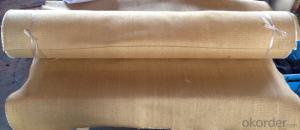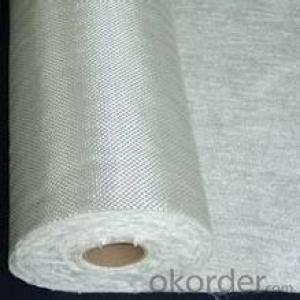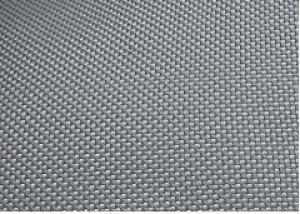Fiberglass Fabrics Silica Fiber Glass Cloth
- Loading Port:
- China Main Port
- Payment Terms:
- TT OR LC
- Min Order Qty:
- -
- Supply Capability:
- -
OKorder Service Pledge
Quality Product, Order Online Tracking, Timely Delivery
OKorder Financial Service
Credit Rating, Credit Services, Credit Purchasing
You Might Also Like
Quick Details
| Place of Origin: | Brand Name: | Model Number: | |||
| Application: | Weight: | Surface Treatment: | |||
| Width: | Weave Type: | Yarn Type: | |||
| Alkali Content: | Standing Temperature: |
Packaging & Delivery
| Packaging Detail: | 50m/carton |
| Delivery Detail: | about 20days |
Specifications
1. High silica glass fiber cloth.
2. High temperature resistance.
3. Instant working temp.: 1400C degree
- Q: How is fiberglass fabric used in the packaging industry?
- Fiberglass fabric is widely used in the packaging industry for various purposes. It is known for its strength, durability, and heat resistance properties, making it an ideal material for packaging applications. One of the primary uses of fiberglass fabric in the packaging industry is as a reinforcement material. It is often used to reinforce cardboard boxes, crates, and other packaging materials to increase their load-bearing capacity. By adding a layer of fiberglass fabric, the packaging becomes more robust and can withstand heavier loads without getting damaged. Fiberglass fabric is also commonly used as a protective lining or wrapping material. It can be used to line the inside of packaging containers, such as drums or barrels, to provide an additional layer of protection. This helps to prevent any leakage or damage to the contents during transportation or storage. Furthermore, fiberglass fabric is utilized for insulation purposes in the packaging industry. It is commonly used to insulate packaging materials that need to maintain a specific temperature, such as cold chain packaging for perishable goods or thermal insulation for sensitive electronics. The heat resistance property of fiberglass fabric helps in maintaining the desired temperature inside the packaging, ensuring the safety and quality of the products. Additionally, fiberglass fabric is also used as a barrier material in the packaging industry. It can be used to create a moisture or vapor barrier by laminating it with other materials. This helps to protect the packaged goods from moisture, humidity, or other external factors that could potentially damage them. In summary, fiberglass fabric is extensively used in the packaging industry for reinforcement, protective lining, insulation, and barrier purposes. Its strength, durability, heat resistance, and insulating properties make it an excellent choice for various packaging applications, ensuring the safety and integrity of the packaged goods.
- Q: Is fiberglass fabric resistant to electrical conductivity?
- Yes, fiberglass fabric is resistant to electrical conductivity. Fiberglass is made from woven fibers of glass, which are non-conductive materials. This means that fiberglass fabric does not allow the flow of electrical current through it. It is commonly used in electrical insulation applications as it provides a protective barrier against electrical shocks and is an excellent insulator. The non-conductive nature of fiberglass fabric makes it a suitable choice for various electrical and electronic applications where the prevention of electrical conductivity is required.
- Q: Can fiberglass fabric be used for masks?
- Yes, fiberglass fabric can be used for masks. Fiberglass fabric is known for its high strength and durability, making it an ideal material for creating protective masks. It is commonly used in industries such as construction, automotive, and aerospace for its ability to withstand high temperatures and provide insulation. When used for masks, fiberglass fabric can provide a strong barrier against particles, dust, and other airborne contaminants. However, it is important to note that fiberglass can be irritating to the skin and respiratory system if not properly handled. Therefore, it is crucial to ensure that the fabric is properly sealed and coated to prevent any contact with the skin or inhalation of fibers.
- Q: What is the basis of testing polyester glass fiber cloth?
- Do not use polyester fiber surface will appear crack reflection in a few months, polyester fiber due to the elongation rate and instantaneous tensile strength is very low, can effectively eliminate the road junction or crack stress concentration, reduce the crack in the pavement and reflected upward, can delay the reflecting crack extend the life of the road, thereby greatly reducing the cost of repair and maintenance.
- Q: Is fiberglass fabric suitable for making protective covers for machinery?
- Yes, fiberglass fabric is suitable for making protective covers for machinery. It is a durable and strong material that offers excellent resistance to heat, chemicals, and abrasion. Additionally, fiberglass fabric is lightweight, flexible, and can be easily molded to fit various shapes and sizes, making it an ideal choice for protective covers that need to provide reliable protection against potential hazards.
- Q: Is fiberglass fabric suitable for making car covers?
- Fiberglass fabric is indeed appropriate for car cover production. It has gained popularity due to its numerous benefits. Firstly, its exceptional durability enables it to withstand adverse weather conditions such as rain, snow, and the sun's harmful UV rays. This guarantees the car's safety and prevents any harm to its paint or interior. Furthermore, its lightweight nature and ease of handling make it convenient for covering and uncovering the vehicle. Its resistance to mildew and mold is also crucial in maintaining the car's cleanliness and preventing unpleasant odors. Moreover, the fabric's breathability allows moisture to escape, preventing condensation from forming on the car's surface. In summary, fiberglass fabric is a dependable and efficient choice for manufacturing car covers, offering remarkable protection and ensuring the car's long lifespan.
- Q: Can fiberglass fabric be used for making speaker cones?
- Yes, fiberglass fabric can be used for making speaker cones. Fiberglass is a lightweight, rigid, and durable material that is often used in the construction of speaker cones. It offers excellent strength-to-weight ratio, which is important for maintaining the structural integrity and responsiveness of the cone. Additionally, fiberglass fabric can be molded into various shapes and sizes, allowing manufacturers to create speaker cones with different designs and performance characteristics. The material also has good acoustic properties, which contribute to the overall sound quality produced by the speaker. However, it is worth noting that the specific characteristics and performance of a speaker cone depend on various factors, including the design, materials used, and manufacturing process. Therefore, while fiberglass fabric can be used for making speaker cones, it is just one of many options available to manufacturers.
- Q: Can fiberglass fabric be used for making molds?
- Indeed, molds can be made using fiberglass fabric. Fiberglass, a versatile material widely utilized in the construction and manufacturing sectors, is renowned for its robustness, longevity, and capacity to assume diverse forms. In the process of mold-making, fiberglass fabric is often overlaid with resin or epoxy to construct a firm and enduring framework. This amalgamation facilitates effortless release of the molded item and imparts a sleek surface. Fiberglass fabric finds utility in a multitude of mold-making endeavors, including the creation of prototypes, sculptures, and even industrial molds.
- Q: Can fiberglass fabric be used in chemical-resistant applications?
- Yes, fiberglass fabric can be used in chemical-resistant applications. Fiberglass fabric is known for its excellent resistance to a wide range of chemicals, making it a suitable choice for applications that involve exposure to various corrosive substances. Fiberglass fabric is inherently resistant to most acids, bases, solvents, and other chemicals, making it a preferred material in industries such as chemical processing, petrochemicals, oil and gas, and wastewater treatment. Additionally, fiberglass fabric can withstand high temperatures, making it even more suitable for chemical-resistant applications where heat is involved. Overall, fiberglass fabric's exceptional chemical resistance properties make it a reliable and durable choice for various chemical-resistant applications.
- Q: Can I put up wall tiles on the bathroom wall waterproof cloth?
- Non-woven fabric, which is similar to a cloth that will base with cement mortar thin brush layer, it can be directly laid on the top.1, note: these three, no matter what kind of waterproof, around 300-500 higher than the ground to prevent water flowing along the wall to the following:1, brush the first waterproof coating. Before construction, make sure that the site is clean and dry, waterproof paint should be painted, no missing, and firmly integrated with the base, no cracks, no bubbles, no shedding phenomenon. Brushing height is consistent, the thickness should meet the product specification requirements.2, brush second times waterproof coating. Note that the first and second times waterproof paint between the need for a certain time interval, the first time after the dry coating can be carried out second times, the specific time depends on the paint. Interval time is too short, waterproof effect will be greatly reduced.3, laying protective layer. To prevent subsequent construction damage to the waterproof layer, it is necessary to put a protective coating on the surface of waterproof coating. The protection layer should be covered with waterproof layer without any omission. It is firmly integrated with the base layer, without cracks, no bubbles and no shedding.
Send your message to us
Fiberglass Fabrics Silica Fiber Glass Cloth
- Loading Port:
- China Main Port
- Payment Terms:
- TT OR LC
- Min Order Qty:
- -
- Supply Capability:
- -
OKorder Service Pledge
Quality Product, Order Online Tracking, Timely Delivery
OKorder Financial Service
Credit Rating, Credit Services, Credit Purchasing
Similar products
Hot products
Hot Searches
Related keywords























